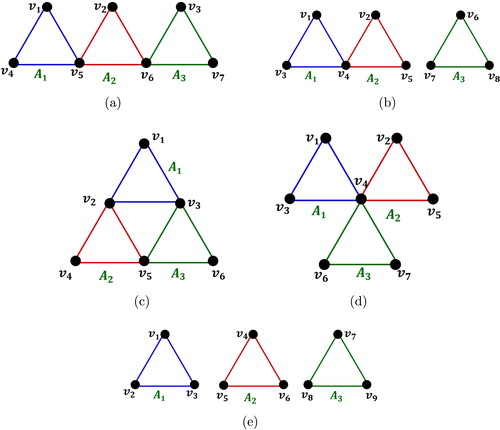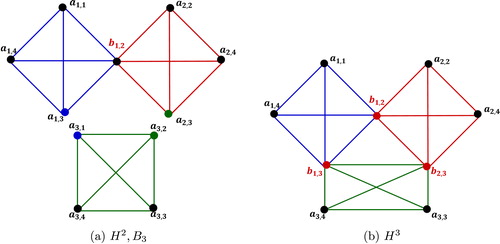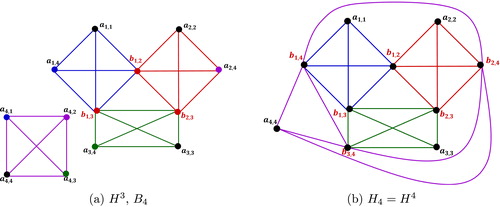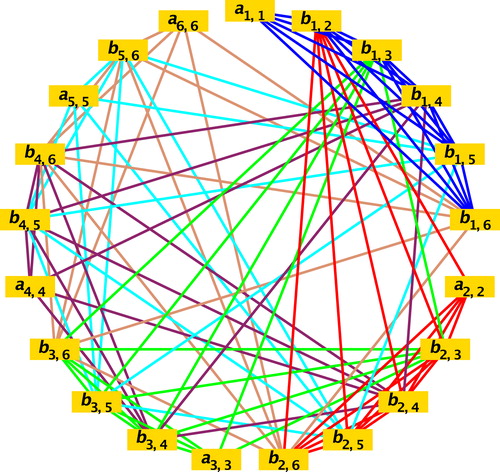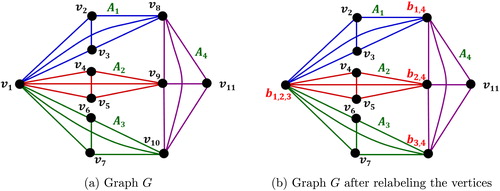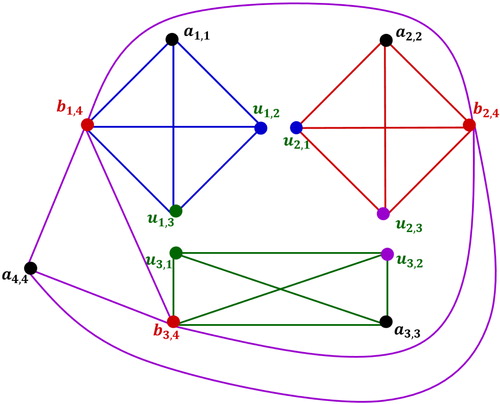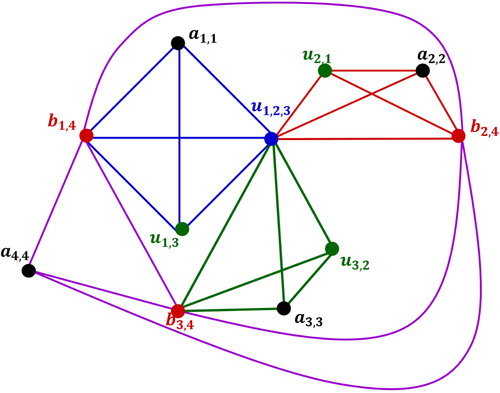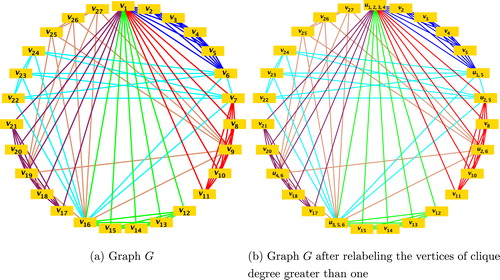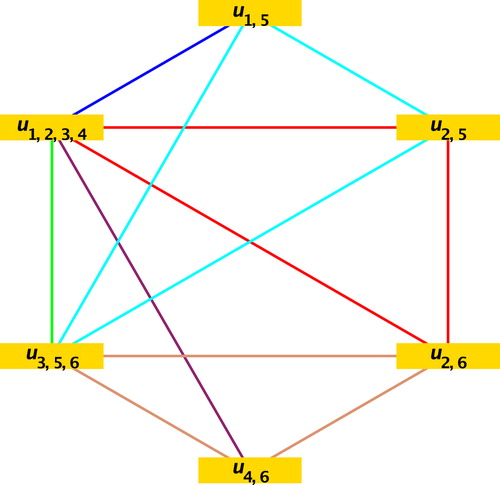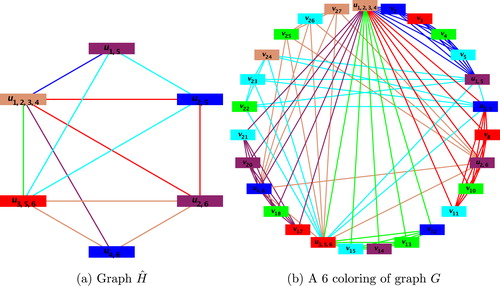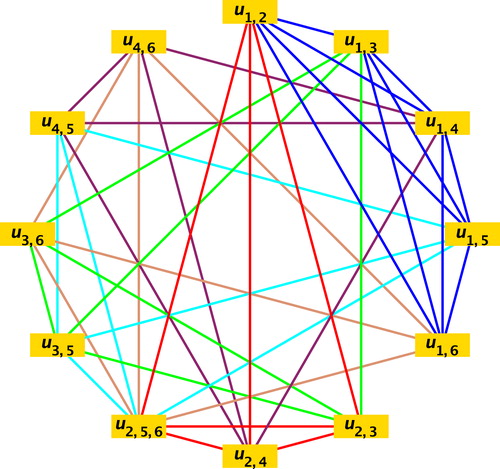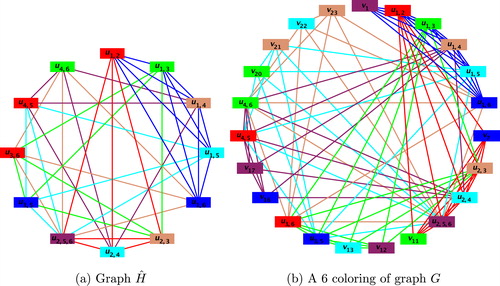 ?Mathematical formulae have been encoded as MathML and are displayed in this HTML version using MathJax in order to improve their display. Uncheck the box to turn MathJax off. This feature requires Javascript. Click on a formula to zoom.
?Mathematical formulae have been encoded as MathML and are displayed in this HTML version using MathJax in order to improve their display. Uncheck the box to turn MathJax off. This feature requires Javascript. Click on a formula to zoom.Abstract
In 1972, Erdős–Faber–Lovász (EFL) conjectured that, if is a linear hypergraph consisting of
edges of cardinality
, then it is possible to color the vertices with
colors so that no two vertices with the same color are in the same edge. In 1978, Deza, Erdös and Frankl had given an equivalent version of the same for graphs: Let
denote a graph with
complete graphs
, each having exactly
vertices and have the property that every pair of complete graphs has at most one common vertex, then the chromatic number of
is
. The clique degree
of a vertex
in
is given by
. In this paper we give a method for assigning colors to the graphs satisfying the hypothesis of the Erdős–Faber–Lovász conjecture and every
(
) has atmost
vertices of clique degree greater than one using Symmetric latin Squares and clique degrees of the vertices of
.
1 Introduction
One of the famous conjectures in graph theory is Erdős–Faber–Lovász conjecture. It states that, if is a linear hypergraph consisting of
edges of cardinality
, then it is possible to color the vertices of
with
colors so that no two vertices with the same color are in the same edge Citation[1]. Erdős, in 1975, offered 50 USD Citation[2,3] and in 1981, offered 500 USD Citation[3,4] for the proof or disproof of the conjecture.
Vance Faber quoted: “In 1972, Paul Erdös, László Lovász and I got together at a tea party in Colorado. This was a continuation of the discussions we had a few weeks before in Columbus, Ohio, at a conference on hypergraphs. We talked about various conjectures for linear hypergraphs analogous to Vizing’s theorem for graphs. Finding tight bounds in general seemed difficult, so we created an elementary conjecture that we thought that it would be easy to prove. We called this the sets problem: given
sets, no two of which meet more than once and each with
elements, color the elements with
colors so that each set contains all the colors. In fact, we agreed to meet the next day to write down the solution. Thirty-Eight years later, this problem is still unsolved in general”.
Chang and Lawler Citation[5] presented a simple proof that the edges of a simple hypergraph on vertices can be colored with at most [1.5n-2] colors. Kahn Citation[6] showed that the chromatic number of
is at most
. Jackson et al. Citation[7] proved that the conjecture is true when the partial hypergraph
of
determined by the edges of size at least three can be
-edge-colored and satisfies
. In particular, the conjecture holds when
is unimodular and
. Viji Paul and Germina Citation[8] established the truth of the conjecture for all linear hypergraphs on
vertices with
. Sanchez-Arroyo Citation[9] proved the conjecture for dense hypergraphs. We consider the equivalent version of the conjecture for graphs given by Deza, Erdős and Frankl in 1978 Citation[4,9–11].
Conjecture 1.1
Let denote a graph with
complete graphs
, each having exactly
vertices and have the property that every pair of complete graphs has at most one common vertex, then the chromatic number of
is
.
Example 1.2
shows all the graphs for which are satisfying the hypothesis of Conjecture 1.1.
Haddad & Tardif (2004) [Citation12] introduced the problem with a story about seating assignment in committees: suppose that, in a university department, there are committees, each consisting of
faculty members, and that all committees meet in the same room, which has
chairs. Suppose also that at most one person belongs to the intersection of any two committees. Is it possible to assign the committee members to chairs in such a way that each member sits in the same chair for all the different committees to which he or she belongs? In this model of the problem, the faculty members correspond to graph vertices, committees correspond to complete graphs, and chairs correspond to vertex colors.
Definition 1.3
Let denote a graph with
complete graphs
,
, each having exactly
vertices and the property that every pair of complete graphs has at most one common vertex. The clique degree
of a vertex
in
is given by
. The maximum clique degree
of the graph
is given by
.
From the above definition, one can observe that degree of a vertex in hypergraph is same as the clique degree of a vertex in a graph.
Definition 1.4
Let and
be two vertex disjoint graphs, and let
be two vertices of
respectively. Then, the graph
obtained by merging the vertices
and
into a single vertex is called the concatenation of
and
at the points
and
(see [Citation13]).
Definition 1.5
A Latin Square is an array containing
different symbols such that each symbol appears exactly once in each row and once in each column. Moreover, a Latin Square of order
is an
matrix
with entries from an
-set
, where every row and every column is a permutation of V (see [Citation14]). If the matrix
is symmetric, then the Latin Square is called Symmetric Latin Square.
In this paper we give a method of coloring to the graph satisfying the hypothesis of the conjecture using a Symmetric Latin Square in the following steps:
| • | Construct the graph | ||||
| • | Construct any other graph satisfying the hypothesis of the conjecture for the same | ||||
| • | We give a coloring to the graph | ||||
| • | Extend the | ||||
2 Construction of 

We know that a symmetric matrix is determined by
scalars. Using symmetric latin squares we give an
-coloring of
constructed below.
Construction of :
Let be a positive integer and
be
copies of
. Let the vertex set
,
.
Step 1. Let .
Step 2. Consider the vertices of
and
of
. Let
be the vertex obtained by the concatenation of the vertices
and
. Let the resultant graph be
.
Step 3. Consider the vertices ,
of
and
,
of
. Let
be the vertex obtained by the concatenation of vertices
,
and let
be the vertex obtained by the concatenation of vertices
,
. Let the resultant graph be
.
Continuing in the similar way, at the th step we obtain the graph
(for the sake of convenience we take
as
).
By the construction of one can observe the following:
| 1. |
| ||||
| 2. |
| ||||
| 3. |
| ||||
| 4. |
| ||||
| 5. | One can observe that in a connected graph | ||||
Following example is an illustration of the graph for
Example 2.1
Let and
be the
copies of
. Let the vertex set
,
.
Step 1: Let . The graph
is shown in .
Step 2: Consider the vertices of
and
of
. Let
be the vertex obtained by the concatenation of vertices
,
. Let the resultant graph be
as shown in .
Step 3: Consider the vertices ,
of
and
,
of
. Let
be the vertex obtained by the concatenation of vertices
,
and let
be the vertex obtained by the concatenation of vertices
,
. Let the resultant graph be
as shown in .
Step 4: Consider the vertices ,
,
of
and
,
,
of
. Let
be the vertex obtained by the concatenation of vertices
,
, let
be the vertex obtained by the concatenation of vertices
,
and let
be the vertex obtained by the concatenation of vertices
,
. Let the resultant graph be
as shown in .
Example 2.2
For , the graph
is shown in .
Lemma 2.3
If is a graph satisfying the hypothesis of Conjecture 1.1, then
can be obtained from
,
in
.
Proof
Let be a graph satisfying the hypothesis of Conjecture 1.1. Let
be the new labeling to the vertices
of clique degree greater than
in
, where
: vertex
is in
. Define
for
. Then the graph
is constructed from
as given below:
Step 1: For every common vertex in
which is not in
, split the vertex
into two vertices
such that vertex
is adjacent only to the vertices of
and the vertex
is adjacent only to the vertices of
in
.
Step 2: For every vertex in
where
, merge the vertices
,
,
,
,
into a single vertex
in
where
and
for
.
Let be the graph obtained in Step 2. Let
,
be the set of all clique degree 1 vertices of
of
,
of
respectively,
. Thus, by splitting all the common vertices of
which are not in
and merging the vertices of
corresponding to the vertices in
, we get the graph
. One can observe that
,
. Define a function
by
One can observe that is an isomorphism from
to
.■
From Lemma 2.3, one can observe that in there are at most
common vertices.
Following example is an illustration of the graph obtained from
for
.
Example 2.4
Let be the graph shown in a.
Relabel the vertices of clique degree greater than one in by
where
for
. The labeled graph is shown in .
Let for
, then
,
.
Consider the graph as shown in , then
and common vertices of
are
. Then
. By the construction given in the proof of Lemma 2.3 we get,
Step 1: Since , split the common vertices of
which are not in
, as shown in .
Step 2: Since , merge the vertices
into a single vertex
, as shown in . Let the resultant graph be
.
The isomorphism is given below.
Fig. 10 A coloring of with six colors . (For interpretation of the references to color in this figure legend, the reader is referred to the web version of this article.)
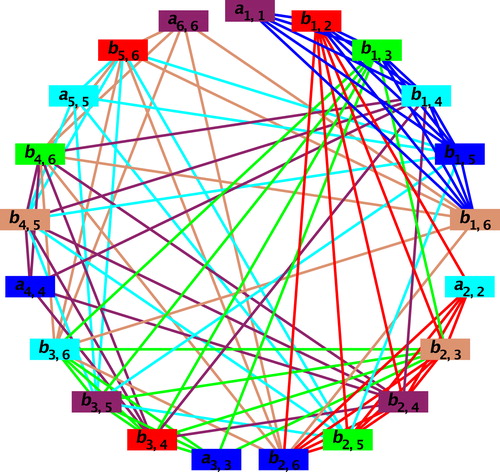
3 Coloring of 

Lemma 3.1
The chromatic number of is
.
Proof
Let be the graph defined as above. Let
(given below) be an
matrix in which an entry
, be a vertex of
, belongs to both
for
and
be the vertex of
which belongs to
. i.e.,
Clearly is a symmetric matrix. We know that, for every
in
there is a Symmetric Latin Square (see [Citation15]) of order
. Bryant and Rodger [Citation16] gave a necessary and sufficient condition for the existence of an
-edge coloring of
(n even), and
-edge coloring of
(n odd) using Symmetric Latin Squares. Let
be the vertices of
and
be the edge joining the vertices
and
of
, where
, then arrange the edges of
in the matrix form
where
,
for
and
for
, we have
and let
be a matrix given by
. Then, define a matrix
as
Let be a matrix where
(
), is the color of
(i.e.,
) and
is the color of
. We call
as the color matrix of
. Then
is the Symmetric Latin Square (see [Citation16]). As the elements of
are the vertices of
, one can assign the colors to the vertices of
from the color matrix
, by the color
, for
and
to the vertex
in
and the color
, for
to the vertex
in
. Hence
is
colorable.■
is the graph satisfying the hypothesis of Conjecture 1.1. By using the coloring of
which is the graph satisfying the hypothesis of Conjecture 1.1 we extend the
-coloring of all possible graphs
satisfying the hypothesis of Conjecture 1.1.
The following example is an illustration of assigning colors to the graph for
.
Example 3.2
Consider the graph as shown in . The corresponding Symmetric Latin Square
of order 6 × 6 is given below:
Assign the six colors to the graph using the above Symmetric Latin Square as follows:
Assign the color (where
denotes the value at the
th entry in the color matrix
) for
and
to the vertex
in
, and assign the color
(where
denotes the value at the
th entry in the color matrix
) for
to the vertex
in
. The colors Red, Green, Cyan, Blue, Tan, Maroon in Fig. 10 corresponds to the numbers 1, 2, 3, 4, 5, 6 respectively in the matrix
.
Then one can verify that the resultant graph is colorable as shown in Fig. 10.
4 Coloring of 

Let be the graph satisfying the hypothesis of Conjecture 1.1. Let
be the graph obtained by removing the vertices of clique degree one from graph
. i.e.
is the induced subgraph of
having all the common vertices of
.
Method for assigning colors to graph satisfying the hypothesis of Conjecture 1.1 and every
(
) has atmost
vertices of clique degree greater than one:
Let be a graph satisfying the hypothesis of Conjecture 1.1 and every
(
) has atmost
vertices of clique degree greater than one. Let
be the induced subgraph of
consisting of the vertices of clique degree greater than one in
. For every vertex
of clique degree greater than one in
, label the vertex
by
where
. Define
,
for
.
Let be the
-colors and
be the color matrix (of size
) as defined in the proof of Lemma 3.1. The following construction applied on the color matrix
, gives a modified color matrix
, using which we assign the colors to the graph
. Then this coloring can be extended to the graph
. Construct a new color matrix
by putting
for every
in
. Also, let
for each
.
Let ,
,
and
.
| Step 1: | If | ||||
| Step 2: | If | ||||
| Step 3: | If | ||||
| Step 4: | Let | ||||
| Step 5: | If | ||||
| Step 6: | If | ||||
Thus, in step 6, we get the modified color matrix . Then, color the vertex
of
by
of
, whenever
. Then, extend the coloring of
to
by assigning the remaining colors which are not used for
from the set of
-colors, to the vertices of clique degree one in
,
. Thus
is
-colorable.
Remark 4.1
One can see that the above method covers the following cases:
| 1. |
| ||||
| 2. |
| ||||
Following is an example illustrating the above method.
Example 4.2
Let be the graph shown in Fig. 11a.
Let ,
,
,
,
,
.
Relabel the vertices of clique degree greater than one in by
where
. The labeled graph is shown in Fig. 11b. Fig. 12 is the graph
, where
is obtained by removing the vertices of clique degree 1 from
.
Let ,
and .
Let 1, 2, , 6 be the six colors and
be the color matrix (as well as symmetric latin square) of order 6 × 6.
Consider the sets ,
,
and
. Then, by applying the aforementioned method we get a new color matrix
by putting
,
for every
in
and
for each
and go to Step 1.
Step 1: Since , choose the vertex
from
. Let
and
, then
and
. Since
, choose the vertex
from
, add it to
and remove it from
. Then
and
. Go to step 2.
Step 2: Since , go to step 3.
Step 3: Since and
, choose the vertex
from
and go to step 4.
Step 4: Since ,
and
, interchange 1, 6 in the matrix
except the color of
. Add the vertex
to
and remove it from
. Then
and
. Go to step 3.
Step 3: Since and
, choose the vertex
from
and go to step 4.
Step 4: Since ,
and
, interchange 2, 6 in the matrix
except the color of
. Add the vertex
to
and remove it from
. Then
and
. Go to step 3.
Step 3: Since and
, choose the vertex
from
and go to step 4.
Step 4: Since ,
and
, interchange 3, 6 in the matrix
except the color of
. Add the vertex
to
and remove it from
. Then
and
. Go to step 3.
Step 3: Since and
, choose the vertex
from
and go to step 4.
Step 4: Since ,
and
, interchange 5, 6 in the matrix
except the color of
. Add the vertex
to
and remove it from
. Then
and
. Go to step 3.
Step 3: Since and
, choose the vertex
from
and go to step 4.
Step 4: Since ,
and
, interchange 2, 6 in the matrix
except the color of
. Add the vertex
to
and remove it from
. Then
and
. Go to step 3.
Step 3: Since , add the vertex
to
and remove it from
, then
and
. Go to step 1.
Step 1: Since , choose the vertex
from
. Let
and
, then
and
. Since
, choose the vertex
from
, add it to
and remove it from
. Then
and
. Go to step 2.
Step 2: Since , go to step 3.
Step 3: Since and
, choose the vertex
from
and go to step 4.
Step 4: Since ,
and
, interchange 5, 6 in the matrix
except the color of
. Add the vertex
to
and remove it from
. Then
and
. Go to step 3.
Step 3: Since and
, choose the vertex
from
and go to step 4.
Step 4: Since ,
and
, interchange 1, 6 in the matrix
except the color of
. Add the vertex
to
and remove it from
. Then
and
. Go to step 3.
Step 3: Since , add the vertex
to
and remove it from
, then
and
. Go to step 1.
Step 1: Since consider
, go to step 5.
Step 5: Since , choose the vertex
from
. Go to step 6.
Step 6: Since appears exactly once in both 1st row and 5th column of the color matrix
. Add the vertex
to
and remove it from
. Then
and
. Go to Step 5.
Step 5: Since , choose the vertex
from
. Go to step 6.
Step 6: Since appears exactly once in both 2nd row and 5th column of the color matrix
. Add the vertex
to
and remove it from
. Then
and
. Go to Step 5.
Step 5: Since , choose the vertex
from
. Go to step 6.
Step 6: Since appears exactly once in both 2nd row and 6th column of the color matrix
. Add the vertex
to
and remove it from
. Then
and
. Go to Step 5.
Step 5: Since , choose the vertex
from
. Go to step 6.
Step 6: Since appears exactly once in both 4th row and 6th column of the color matrix
. Add the vertex
to
and remove it from
. Then
and
. Go to Step 5.
Step 5: Since , consider
.
Stop the process.
Assign the colors to the graph using the matrix
, i.e., color the vertex
by the
th entry
of the matrix
, whenever
(see Fig. 13a), where the numbers 1, 2, 3, 4, 5, 6 correspond to the colors Green, Cyan, Blue, Maroon, Tan, Red respectively. Extend the coloring of
to
by assigning the remaining colors which are not used for
from the set of
-colors to the vertices of clique degree one in each
,
. The colored graph
is shown in Fig. 13b.
Following example shows that the aforementioned method does not work, if the graph has more than
vertices of clique degree greater than one in some
,
.
Example 4.3
Let be the graph shown in Fig. 14a.
Let ,
,
,
,
,
.
Relabel the vertices of clique degree greater than one in by
where
. The labeled graph is shown in Fig. 14b. Fig. 15 is the graph
, where
is obtained by removing the vertices of clique degree 1 from
.
Let ,
and
.
Let 1, 2, , 6 be the six colors and
be the color matrix (as well as symmetric latin square) of order 6 × 6.
Consider the sets ,
,
and
. Then by applying the aforementioned method we get a new color matrix
by putting
,
for every
in
and
for each
and go to Step 1.
Step 1: Since , choose the vertex
from
. Let
and
, then
and
. Since
, choose the vertex
from
, add it to
and remove it from
. Then
and
. Go to step 2.
Step 2: Since , go to step 3.
Step 3: Since and
, choose the vertex
from
and go to step 4.
Step 4: Since ,
and
, interchange 2, 1 in the matrix
except the color of
. Add the vertex
to
and remove it from
. Then
and
. Go to step 3.
Step 3: Since and
, choose the vertex
from
and go to step 4.
Step 4: Since ,
and
, interchange 4, 1 in the matrix
except the color of
. Add the vertex
to
and remove it from
. Then
and
. Go to step 3.
Step 3: Since , add the vertex
to
and remove it from
, then
and
. Go to step 1.
Step 1: Since consider
, go to step 5.
Step 5: Since , choose the vertex
from
. Go to step 6.
Step 6: Since appears exactly once in both 1st row and 2nd column of the color matrix
. Add the vertex
to
and remove it from
. Then
and
. Go to Step 5.
Step 5: Since , choose the vertex
from
. Go to step 6.
Step 6: Since appears exactly once in both 1st row and 3rd column of the color matrix
. Add the vertex
to
and remove it from
. Then
and
. Go to Step 5.
Step 5: Since , choose the vertex
from
. Go to step 6.
Step 6: Since appears exactly once in both 1st row and 4th column of the color matrix
. Add the vertex
to
and remove it from
. Then
and
. Go to Step 5.
Step 5: Since , choose the vertex
from
. Go to step 6.
Step 6: Since and it appears more than once in the 5th column of the color matrix
. Let
,
, then
= {1, 2, 3, 4, 5, 6} and
.
It cannot be go further.
In the illustration of Example 4.3, if we choose the color matrix (symmetric latin square) given below, then exists an -coloring of
.
Let .
Applying the method in Example 4.3, we get
Color the vertex by the
th entry
of the matrix
, whenever
(see Fig. 16a), where the numbers 1, 2, 3, 4, 5, 6 correspond to the colors Blue, Red, Green, Maroon, Tan, Cyan respectively. Extend the coloring of
to
by assigning the remaining colors which are not used for
from the set of
-colors to the vertices of clique degree one in each
,
. The colored graph
is shown in Fig. 16b.
Remark 4.4
From the above example, one can see that the method will work for some symmetric latin squares and will not work for some other, for the graphs having more than vertices of clique degree greater than one in some
(
) in
.
Acknowledgment
We thank Dr. Vance Faber, Center for Computing Sciences, Bowie, MD, USA for his valuable suggestions during this research work.
References
- BergeClaude, On two conjectures to generalize Vizing’s theorem Matematiche (Catania) 45 1 1990 15–23 (1991)Graphs, designs and combinatorial geometries (Catania, 1989)
- ErdősPAUL, Problems and results in graph theory and combinatorial analysis Proc. British Combinatorial Conj., 5th1975 169–192
- ErdősPál, On the combinatorial problems which i would most like to see solved Combinatorica 1 1 1981 25–42
- JensenTommy RToftBjarne, Graph Coloring Problems, Vol. 392011John Wiley & Sons
- ChangWilliam I.LawlerEugene L., Edge coloring of hypergraphs and a conjecture of Erdös, Faber, Lovász Combinatorica 8 3 1988 293–295
- KahnJeff, Coloring nearly-disjoint hypergraphs with n+o(n) colors J. Combin. Theory Ser. A 59 1 1992 31–39
- JacksonBillSethuramanG.WhiteheadCarol, A note on the Erdős-Farber-Lovász conjecture Discrete Math. 307 7–8 2007 911–915
- PaulVijiGerminaK.A., On edge coloring of hypergraphs and Erdös-Faber-Lovász conjecture Discrete Math. Algorithms Appl. 4 1 2012 12500035
- Sánchez-ArroyoAbdón, The Erdős-Faber-Lovász conjecture for dense hypergraphs Discrete Math. 308 5–6 2008 991–992
- DezaMErdösPFranklP, Intersection properties of systems of finite sets Proc. Lond. Math. Soc. 3 2 1978 369–384
- MitchemJohnSchmidtRandolph L., On the Erdős-Faber-Lovász conjecture Ars Combin. 972010 497–505
- HaddadLucienTardifClaude, A clone-theoretic formulation of the Erdös-Faber-Lovász conjecture Discuss. Math. Graph Theory 24 3 2004 545–549
- KunduSukhamaySampathkumarEShearerJamesSturtevantDean, Reconstruction of a pair of graphs from their concatenations SIAM J. Algebr. Discrete Methods 1 2 1980 228–231
- LaywineCharles FMullenGary L, Discrete Mathematics using Latin Squares, Vol. 171998Wiley New York
- YeXiaoruiXuYunqing, On the number of symmetric latin squares Computer Science and Service System (CSSS), 2011 International Conference on2011IEEE2366–2369
- BryantDarrynRodgerCA, On the completion of latin rectangles to symmetric latin squares J. Aust. Math. Soc. 76 1 2004 109–124

